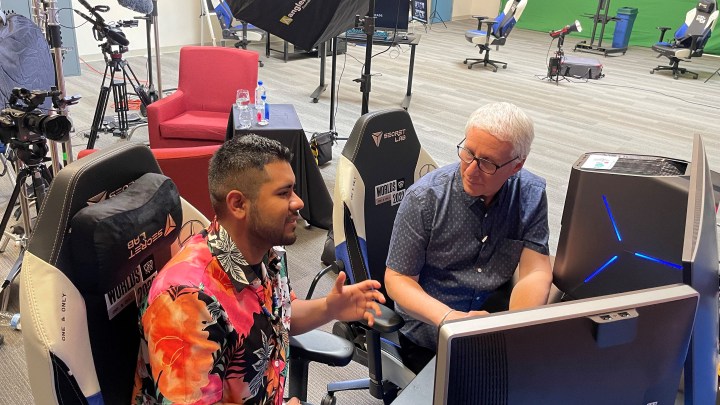
This video game teaches players about gentrification
This video game teaches players about gentrification

The business of video games is bigger than movies and music combined. What can the games — and the vast industry that surrounds them — teach us about economics, business, money, and careers? We are starting a project on the “Marketplace Morning Report” called “Skin in the Game”: A full-immersion virtual adventure with younger people cracking into the industry itself.
Simeon Tedros is all velcro-ed up in a black polyester jump suit studded with wireless sensors. As he moves his limbs, a digital mannequin on a screen tracks his movements. Tedros — a high schooler — is learning how to use a motion capture suit to create a virtual character in a video game.
“It is pretty fun,” said Tedros. “Very expensive though.”
It’s part of a nonprofit mentoring program in Oakland, California, called Gameheads where, starting in high school, people go from playing video games to making them. It’s striking to see how students focused on creating games that draw from their lived experience. Some explore anxiety, or grief, or matters economic.
For Rogelio Lara, who first came to Gameheads when he was 16, it’s gentrification.
“The concept of the game is trying to explain to people gentrification in the eyes of a cashier,” explained Lara.
It’s a complex idea to take on: What is gained and what is lost when higher-income people move into a lower-income part of town? Lara’s team calls the game “Here’s Your Change.” Players scroll across a sidewalk to a corner store. Early in the game, you see buildings that are worse for wear. But inside the shop, players find the cashier personable and at one with her customers.

“One of the first game levels is this guy comes in and he’s like, ‘Hey, man, have you listened to my mixtape?'” explained Lara. “And we were having a little bit of fun there, but the idea is, when individuals enter into this neighborhood, you get to know these individuals from a personal, interconnected level, right? You get to understand the cultural aspect of it, the dialect, the slang. But as the you continue to play the game, the next level then becomes more of a gentrified neighborhood.”

The student team created a series of dialogs between the customer — meaning you, the player — and the cashier. Enough back-and-forth bits of conversation, and the game takes you up a level where the street view is getting spruced up. But here’s the thing: As the neighborhood gets glossier, the interactions with the cashier get more formal.
“You have this sense of community where things are followed down to … not necessarily strict laws, but more like unwritten social rules,” said Lara. “But now as gentrification begins to start, these conversations are starting to disappear.”
“This is a very, ‘I need something from you, you need something for me,'” explained Brandon Charles, a fellow student developer. “There’s no personal level there. It’s very kinda sad.”
“Brandon was actually a cashier when we were making this game,” said Lara. “So we asked him opinions on like, ‘Hey, is this a realistic conversation?'”
Charles joined Gameheads while also working in the real world at a place in Oakland owned by his family, selling groceries and drinks. As the neighborhood attracted people with more money, he saw brands of bottled water at his store go upscale. Some changes were welcome, like offering fresh fruit and vegetables for sale. But he wanted the game to reflect the shift in tone he witnessed.
“You get people coming in and be like, ‘Hey, do you have this product?’ You’re like, ‘I don’t even know what that is,'” said Charles. “Or you’ll have people come in and be like, ‘Do you take this app for payment?’ ‘I’m sorry, we don’t.’ “
In the game, payment also changes over time.
“So to start off, you can take credit card but you can’t take like things like Apple Pay or stuff like that, and then eventually that changes and you end up being able to take Apple Pay in the second stage,” said Charles. “And then toward the end, you can’t take cash. Where in the beginning it was very focused on the cash format, you have to actually, like, get change and stuff like that. Which is where the (title) ‘Here’s Your Change’ comes from.”
Lisette Titre-Montgomery is a video game art director with more than 20 years experience who’s worked on some big titles including “Sims 4” and “Psychonauts 2.” She teaches at Gameheads and is on the advisory board. She calls “Here’s Your Change” an “empathy exercise.”

“So how do you take a concept as complex as gentrification, and turn it into a topic that you can play?” Titre-Montgomery asked. “You hone in on the verbs, the words of things that a player can do: sell, buy, right? Then, distill that into a specific moment or scene or experience that that can turn into a playable experience or game.”
Lara has just finished college and wants to teach and to develop video games to help him do that. As for Charles, at some level, he’s living the dream. He once wanted to be an anesthesiologist, but with Gameheads under his belt, he’s now finished college and has a job designing virtual experiences for one of George Lucas’ companies in San Francisco.
There’s a lot happening in the world. Through it all, Marketplace is here for you.
You rely on Marketplace to break down the world’s events and tell you how it affects you in a fact-based, approachable way. We rely on your financial support to keep making that possible.
Your donation today powers the independent journalism that you rely on. For just $5/month, you can help sustain Marketplace so we can keep reporting on the things that matter to you.


















